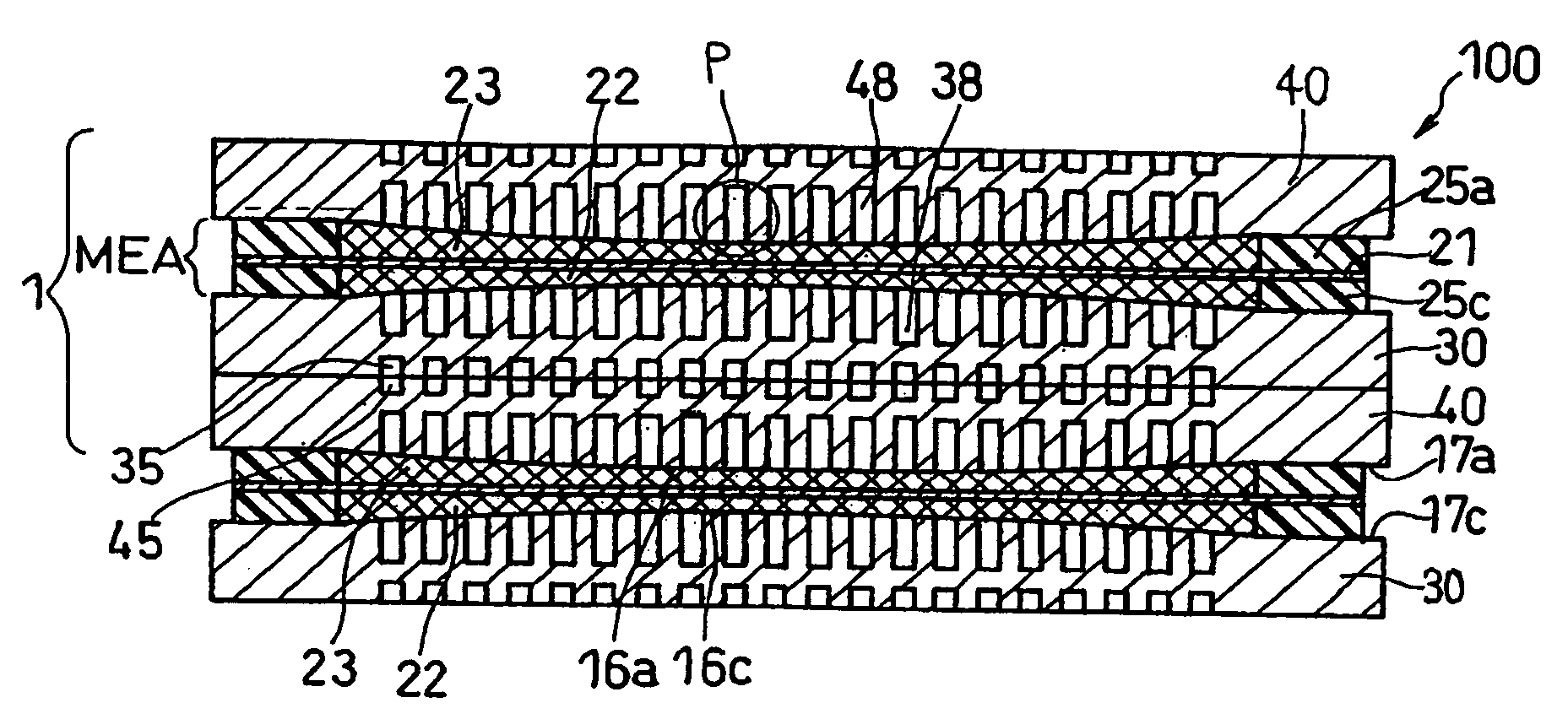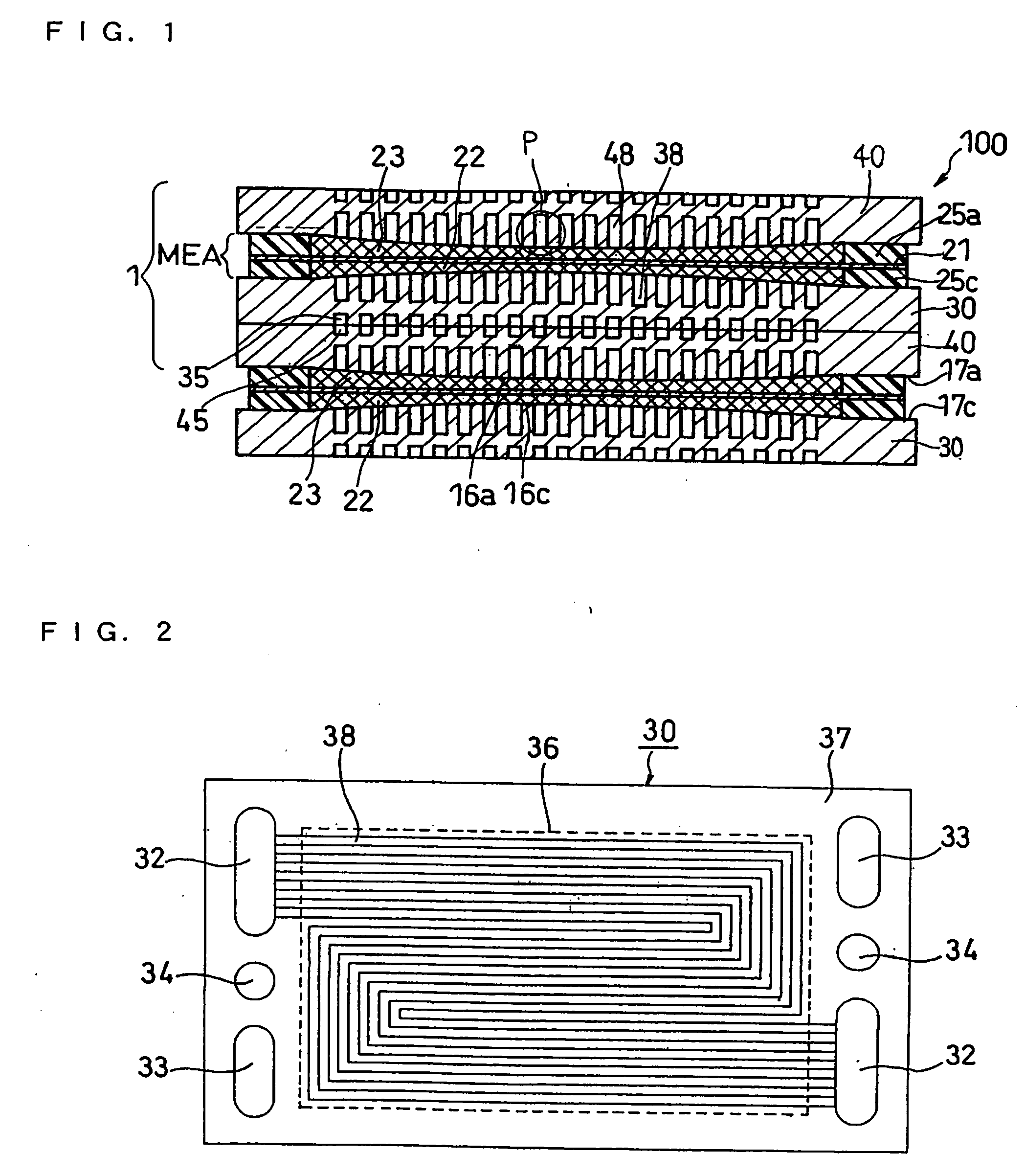Polymer electrolyte fuel cell
a fuel cell and electrolyte technology, applied in the field of polymer electrolyte fuel cells, can solve the problems of gas diffusivity disturbance, increased pressure loss of the unit cell b>101/b>, and gas diffusion layer buckled, etc., to achieve increase electrical resistance, and easy and reliably embodied
- Summary
- Abstract
- Description
- Claims
- Application Information
AI Technical Summary
Benefits of technology
Problems solved by technology
Method used
Image
Examples
embodiment 1
[0044]FIG. 1 is a schematic sectional view illustrating a basic structure of a polymer electrolyte fuel cell in Embodiment 1 of the present invention. As shown in FIG. 1, a unit cell 1, i.e., a basic structure of the polymer electrolyte fuel cell 100 in this embodiment, mainly comprises a polymer electrolyte membrane 21 which selectively transfers cation (hydrogen ion), and a pair of electrodes (anode and cathode) 22, 23 disposed on both sides of the polymer electrolyte membrane 21. A cathode 22 and an anode 23 are composed of a catalyst layer comprising a mixture of a carbon powder carrying an electrode catalyst (platinum for example) and a hydrogen ion conductive polymer electrolyte, and a gas diffusion layer comprising for example a water repellent treated carbon paper, formed on outside of the catalyst layer and having both gas permeability and electron conductivity.
[0045] Then, gas sealing members such as gaskets 25a and 25c are disposed to sandwich the polymer electrolyte mem...
embodiment 2
[0070] Next, a polymer electrolyte fuel cell in Embodiment 2 of the present invention will be described. In this polymer electrolyte fuel cell in Embodiment 2, the combination of the anode side separator plate 30 and the cathode side separator plate 40 in the polymer electrolyte fuel cell 100 in Embodiment 1 shown in FIG. 1 is replaced by a single composite separator plate 50, as shown in FIG. 8, and the construction except for the composite separator plate 50 is the same as that of the polymer electrolyte fuel cell 100 in Embodiment 1. FIG. 8 is a schematic sectional view illustrating a basic structure of the polymer electrolyte fuel cell in Embodiment 2 of the present invention.
[0071] In the following, the composite separator plate 50 provided in a polymer electrolyte fuel cell 200 in Embodiment 2 (a separator plate in Embodiment 2 of the present invention) is described. FIG. 9 is a front view enlarging a main portion of the composite separator plate 50 in the polymer electrolyte...
example 1
[0084] A polymer electrolyte fuel cell of the present invention comprising a unit cell 1 was made by using the cathode side separator plate 30 and the anode side separator plate 40 in the above Embodiment 1.
[0085] First, a cathode catalyst-carrying carbon powder (Pt:50 weight %) is obtained by causing a conductive carbon powder having an average primary particle size of 30 nm (Ketjen black EC (a product name): product of AKZO Chemie B.V., the Netherlands) to carry platinum particles having an average particle size of 3 nm. Also, an anode catalyst-carrying carbon powder (Pt:25 weight %, Ru:25 weight %) is obtained by causing the same conductive carbon powder as the above to carry platinum particles and ruthenium particles each having an average particle size of 30 angstrom.
[0086] The above cathode catalyst-carrying carbon powder is dispersed in isopropanol, and then an ethyl alcohol dispersion of perfluorocarbon sulfonic acid powder was mixed, so as to prepare a paste for forming a...
PUM
| Property | Measurement | Unit |
|---|---|---|
| thickness | aaaaa | aaaaa |
| thickness | aaaaa | aaaaa |
| thickness | aaaaa | aaaaa |
Abstract
Description
Claims
Application Information
 Login to View More
Login to View More - R&D
- Intellectual Property
- Life Sciences
- Materials
- Tech Scout
- Unparalleled Data Quality
- Higher Quality Content
- 60% Fewer Hallucinations
Browse by: Latest US Patents, China's latest patents, Technical Efficacy Thesaurus, Application Domain, Technology Topic, Popular Technical Reports.
© 2025 PatSnap. All rights reserved.Legal|Privacy policy|Modern Slavery Act Transparency Statement|Sitemap|About US| Contact US: help@patsnap.com



